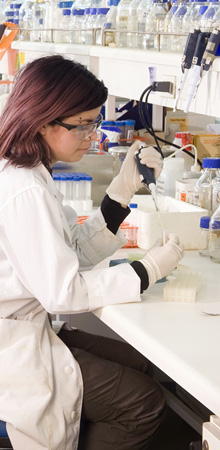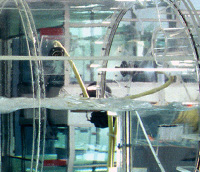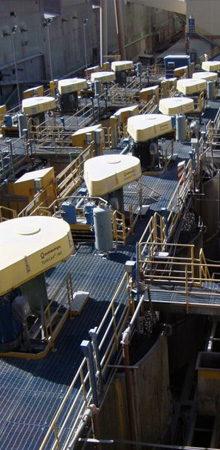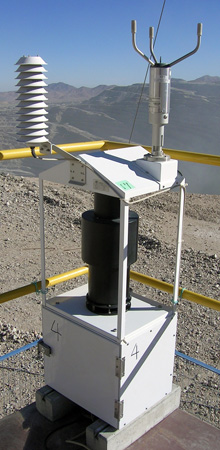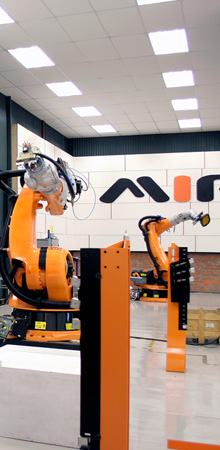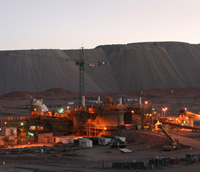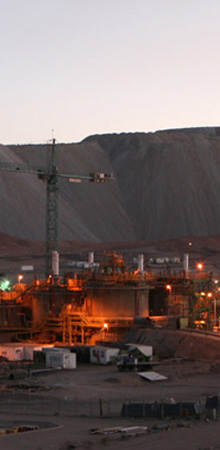Technological Innovation and Research

The ongoing search for and development of technological innovations is a strategic activity for Codelco. The incorporation of new technologies in the mining-metallurgical processes aims to increase productivity, improve safety at work and ensure the protection of the environment.
In 2010, Codelco invested US$ 78 million in various corporate technological programmes and projects; in the framework of technological research and development, and innovation initiatives. This also includes projects developed by Codelco subsidiaries and related companies.
The most significant progress during the period was as follows:
Â
Technological Development
Corresponds to multi-year initiatives aimed to solve specific and key challenges for Codelco.
Underground Mining
The main objective is to significantly improve productivity of block caving and its employment in Codelco’s new projects.
Since 2000 the Company has developed four lines of research:
- Pre-condition,
- Transition mining,
- Mining preparation and
- Continuous mining.
Pre-condition aims to modify the rock characteristics, applying a combination of hydraulic fracturing and blasting with explosives. In 2010, key activities were the blast test and evaluation at El Teniente Division and 2011 blast plan preparation for blasting at 200 metres above sea level at Andina Division. Data gathering was also completed, consolidating all the information acquired during the last 10 years.
Transition mining focused on preparing the application test for the Sizer equipment at El Teniente Division in 2011, this includes construction, equipment procurement and test protocols.
Metallurgical validation studies were also carried out on the Sizer crushing equipment, based on the results obtained at Andina Division in 2010.
In mine preparation, prefabricated frames to reinforce the extraction points were tested and are currently being assessed to see their behaviour in operating conditions underground. As for rapid tunnel development, the complete section equipment application was conceptually assessed.
Together with supplier companies, the conceptual design of the equipment was developed for a complete section and it was agreed that its experimental application would be used in Codelco divisions and projects.
Codelco considers the future development of low-cost, high yield and ecofriendly, automated continuous underground mining. In 2010, continuous mining focused on selecting a sector at Andina Division to apply its mass implementations. The associated basic and conceptual engineering study was developed and completed in March 2011. Secondary blasting equipment was looked for in order to ensure the flow of mineral ore during the operation. Furthermore, basic engineering was carried out for equipment that safely locates and installs charges in the rock, which was one of the solutions studied for chained rocks, that are currently a risk to the operation and the material-managing equipment is less productive.
Open-Pit Mining
In the medium term, the aim is to develop and validate theoretical blast designs, slope engineering and industrial assessment of autonomous transport initiatives.
In 2010, work was jointly undertaken with Acumine, an Australian company, on the conceptualisation of Automated Open-Pit Mining and resources were requested to implement the first stage of the project, scheduled to start in 2011.
Furthermore, the Acumine-Micomo Collision Avoidance System began to be applied at an industrial level on the entire Andina Division mine fleet, to significantly improve safety at the operations. The system was installed in ten machines at Radomiro Tomic mine as a pilot test.
The Company worked jointly with its subsidiary IM2 assessing the impact of Vertical Slope technology, applied in a section of the Mina Sur mine, in the Chuquicamata’s transition from an open-pit mine to an underground mine and in Toqui Mine at Chuquicamata Division. In the cases analysed, there is a potential impact on the projects’ profitability and output capacity.
Â
Mineral Processing
In 2010, focus was on the efficient use of energy and water and on increasing mineral recovery.
In comminution technologies, an Electrodynamic Control Ball for SAG Mill was designed, built and tested; it monitors online the grinding component movements inside the machinery, improving process control. This invention is currently being patented.
Another initiative was the lab scale assessment of an electrodynamic fracturing technology that had promising results; it aims to significantly reduce energy consumption in the comminution process.
A semi-pilot test was also implemented in a Loesche mill, in Germany. The technology being tested is based on mineral attrition with rotating components. Tests were carried out on mineral ore and slag samples. The results, which demonstrated an important reduction in energy consumption, have to be validated at a larger scale.
Studies were undertaken to determine the Seismic Stability of the Carén Dam at El Teniente Division. The idea was to put paste on the tailings dump. The study involved taking samples from different places in the dump, and modelling the stability conditions under different applications. The results showed that it is safe to use paste in the Carén dam.
Additionally, using tailings at the Division, thickness tests were carried out at a pilot plant in the dam. Results showed that the thickening technology increases solids to 66%, with the consequent water recovery and improved efficiency of the tailings dams. As for optimised mineral recovery, Andina Division assessed the Molybdenum Recovery technology at industrial level, by injecting emulsified flotation reactive in micro-bubbles.
Â
Concentrate Smelter
In the Continuous Smelting programme, important progress was made in the continuity and integration of pyrometallurgical processes. Based on fluid-dynamics and metallurgical models, an operational methodology was structured at the Potrerillos smelter, to apply a continuous fusion process at El Teniente converter and semi-continuous cleaning in the slag cleaning furnace.
Additionally, progress was made in developing devices to measure variables in the line process, such as phase level, magnetite and copper sensors. The analysis covered conversion operating practices in use at the Chuquicamata and Caletones smelters, as well as the corresponding theoretical support, it opens the way to continue developing continuous anode refining technology.
Â
In Situ Mining
In 2010, the impact of using confined blasting in a deposit was assessed to improve permeability of solutions through rock and its effect on the process. The results showed improvement in rock permeability.
A Phenomenological Model was validated, that forecasts and estimates parameters and determines the technical feasibility of the process. A case study was also carried out at Salvador Division, where the economic benefit of implementing In-Situ Leaching technology using confined blasting was assessed.
Â
Remaining Resources
Engineering studies undertaken in order to validate the geological-mining- metallurgical base and assess the viability of extracting the remaining resources in the Inca deposit at Salvador Division. 16,000 metres of ascending reverse circulation drilling were completed and enhancements were made to the mass balance methodology in order to speed up the validation of the broken ore model.
Additionally, mine planning studies were carried out to assess the interference of the future open-pit mine with the current underground plan, in order to define mining scenarios with more economic-technical potential.
Â
Water Treatment
A pilot test programme was developed to validate the Sulphate Abatement technologies for sulphates contained in water.
The project was centred in Andina to treat infiltrated water. A test was applied using bio-reduction technology, applied by the Dutch Company Paques; and technologies provided by Veolia and Harrison Western were chosen to start work on the pilot plants. The goal is to have a validated technology to abate sulphates.
Â
Intellectual Property
An Intellectual Property Protection Management System was implemented in the Company. It is a computer system that records and monitors the in-house patent procedure and the external process at the Instituto Nacional de Ownership Intelectual, INAPI. Thereby it keeps track of actions and authorisations, and it has a high security level as well as restricted access since it deals with the Company’s confidential information.
A Technological Development Assessment Manual was prepared that sets out the procedures to assess any innovation proposal.

Science and Technology
Codelco has developed an approach focused on developing alliances with leading R&D companies and organisations, both in Chile and overseas. Its goal is to promote the incorporation of innovation and technology to improve productivity and sustainability.
In 2010, Codelco participated in the implementation of the following projects and initiatives together with Chilean universities, international institutions and companies:
Â
Projects Fondef
- Multivariable modelling for deposit assessment (Universidad de Chile).
- Methodologies to assess long-term copper mining plans with uncertain prices and ore grade (Universidad de Chile).
- Generation of a commercial technological packet to implement solar wind technology at an industrial scale (Fundación Palma).
Â
Projects sponsored by Corfo
- Development of a local capacity and knowledge platform to create new products using the bactericidal properties of copper (International Copper Association, ICA).
- Prospecting for the standardisation of mining objects (Universidad de Chile and Freeport McMoran), which aims to set standards to develop mining software.
- Applications and challenges of molybdenum for the industry and researchers in Chile (Molymet and Universidad de Chile).
- In 2009, Codelco and OTRI Chile jointly developed the project Strengthening the Technological Business Market based on National Inventions, which was sponsored by Innova Chile, Enami, Sonami, Drillco and Indura. Its objective is to bring together inventors and the mining industry through a national competition. Among the proposals submitted, Codelco has been developing the Detector of Failures in Conveyor Belts project since 2010.
International Collaborative Research Projects
- Geometalurgical Mapping and Mine Modelling: this international, multicompany collaborative project, managed by AMIRA, aims to develop new tools for the prediction of mineral behaviour at plants. In 2010, work started on the ore characterisation study at Andina and Chuquicamata divisions, with new techniques developed during the previous project stage.
- Hybrid Stress Blasting Model: this project was completed in 2009, therefore in 2010 research focused on how to approach a complementary stage so as to consolidate results, ensure the software works, validate the model with industrial information and calibrate its parameters with real results. This complementary stage is scheduled to be completed in 2012.
- Mass Mining Technologies: The second phase of this project was started, in which ten mining companies are involved. The initiative will last three years and it will provide further knowledge on Block Caving methods in underground mining, specifically in gravitational flow, block caving mechanics, primary comminution and subsidence.
- RÃo de Cobre (River of Copper): In the context of this technological alliance between Codelco and Rio Tinto, activities were carried out to develop underground mining projects and mineral processing. Additional activities were implemented to share knowledge and experience, in the application of technologies and knowledge protection strategies related to technology development.
Automation, telecommunications and information technologies
Codelco believes that information, telecommunications and automation technologies (TICA) are essential to enable new work models and to ensure the future and sustainable viability of mining. This strategy, called Codelco Digital, gives priority to the efficient use of these technologies, focused on mining production processes. In 2010, key innovation projects, TICA applied to mine management, were as follows:
- Start-up of Integrated Operations Centre at Andina Division, the first control centre in the mining industry where an integrated data platform of all the production processes was launched.
- Mine fleet management, in the open-pit and underground mine services where implemented that incorporated standard technology that enable the company to continuously enhance mining processes. Particularly, the application of high precision technologies and their integration from the mine operations into the ERP/SAP system.
- Consolidation of an operational management platform, based on the PI System technology, as data support and business knowledge base, which provides real time data on Codelco’s mining operations.
- Codelco entered an agreement with Microsoft to explore the creation of a Mining Software Solution Centre, in northern Chile. The initiative involves experts assigned by both companies, who work with specialised support centres overseas and are creating a project portfolio and associated business cases.







